Page 59 of 394
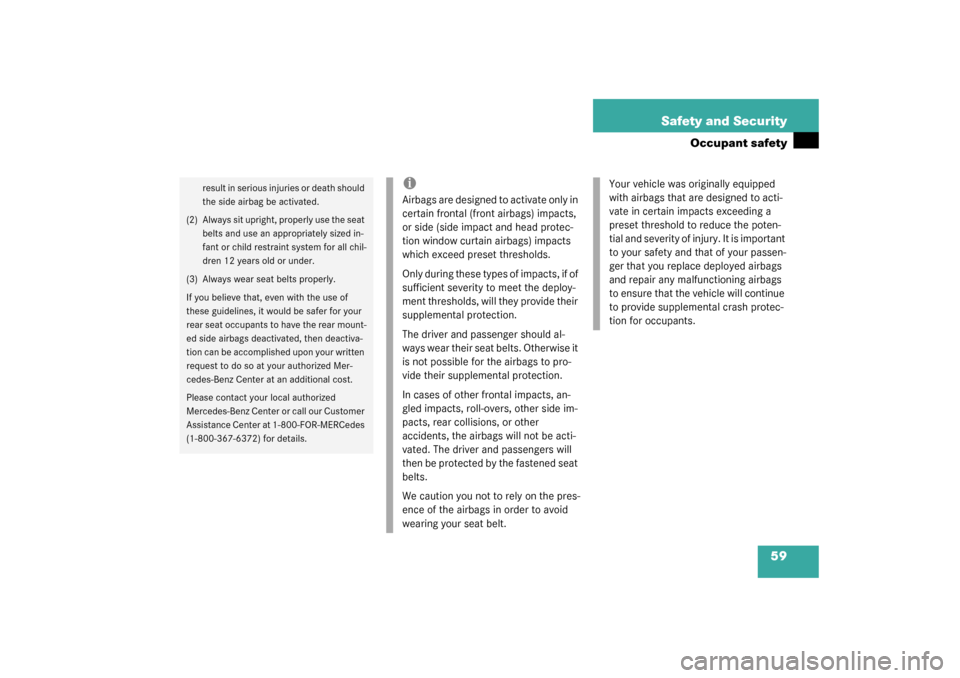
59 Safety and Security
Occupant safety
result in serious injuries or death should
the side airbag be activated.
(2) Always sit upright, properly use the seat
belts and use an appropriately sized in-
fant or child restraint system for all chil-
dren 12 years old or under.
(3) Always wear seat belts properly.
If you believe that, even with the use of
these guidelines, it would be safer for your
rear seat occupants to have the rear mount-
ed side airbags deactivated, then deactiva-
tion can be accomplished upon your written
request to do so at your authorized Mer-
cedes-Benz Center at an additional cost.
Please contact your local authorized
Mercedes-Benz Center or call our Customer
Assistance Center at 1-800-FOR-MERCedes
(1-800-367-6372) for details.
iAirbags are designed to activate only in
certain frontal (front airbags) impacts,
or side (side impact and head protec-
tion window curtain airbags) impacts
which exceed preset thresholds.
Only during these types of impacts, if of
sufficient severity to meet the deploy-
ment thresholds, will they provide their
supplemental protection.
The driver and passenger should al-
ways wear their seat belts. Otherwise it
is not possible for the airbags to pro-
vide their supplemental protection.
In cases of other frontal impacts, an-
gled impacts, roll-overs, other side im-
pacts, rear collisions, or other
accidents, the airbags will not be acti-
vated. The driver and passengers will
then be protected by the fastened seat
belts.
We caution you not to rely on the pres-
ence of the airbags in order to avoid
wearing your seat belt.
Your vehicle was originally equipped
with airbags that are designed to acti-
vate in certain impacts exceeding a
preset threshold to reduce the poten-
tial and severity of injury. It is important
to your safety and that of your passen-
ger that you replace deployed airbags
and repair any malfunctioning airbags
to ensure that the vehicle will continue
to provide supplemental crash protec-
tion for occupants.
Page 61 of 394
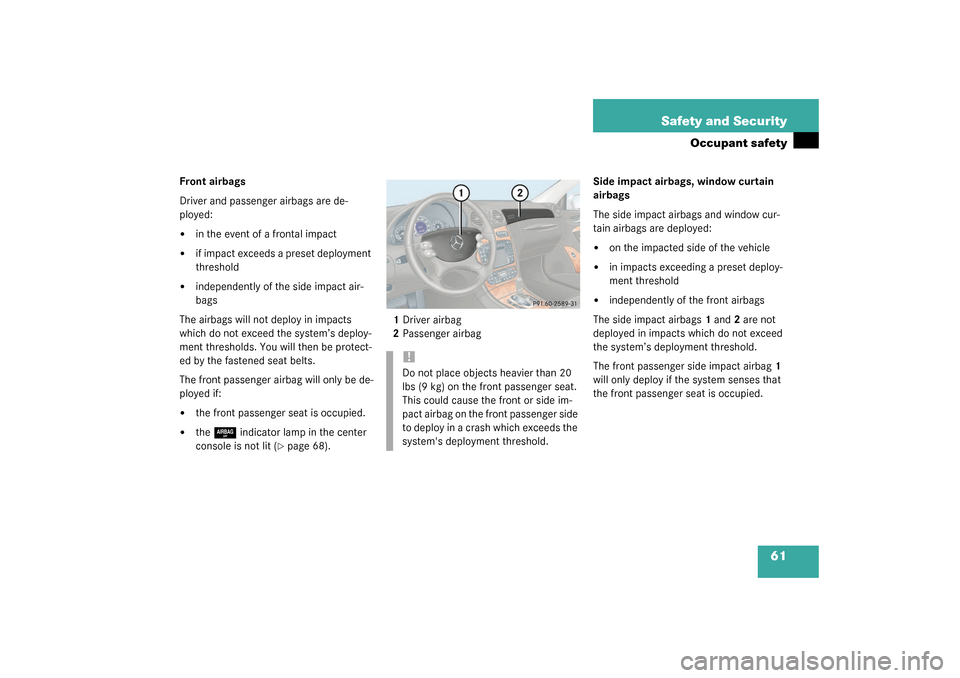
61 Safety and Security
Occupant safety
Front airbags
Driver and passenger airbags are de-
ployed: �
in the event of a frontal impact
�
if impact exceeds a preset deployment
threshold
�
independently of the side impact air-
bags
The airbags will not deploy in impacts
which do not exceed the system’s deploy-
ment thresholds. You will then be protect-
ed by the fastened seat belts.
The front passenger airbag will only be de-
ployed if:
�
the front passenger seat is occupied.
�
the
7
indicator lamp in the center
console is not lit (
�page 68).1Driver airbag
2Passenger airbagSide impact airbags, window curtain
airbags
The side impact airbags and window cur-
tain airbags are deployed:
�
on the impacted side of the vehicle
�
in impacts exceeding a preset deploy-
ment threshold
�
independently of the front airbags
The side impact airbags1and2 are not
deployed in impacts which do not exceed
the system’s deployment threshold.
The front passenger side impact airbag1
will only deploy if the system senses that
the front passenger seat is occupied.
!Do not place objects heavier than 20
lbs (9 kg) on the front passenger seat.
This could cause the front or side im-
pact airbag on the front passenger side
to deploy in a crash which exceeds the
system's deployment threshold.
Page 62 of 394
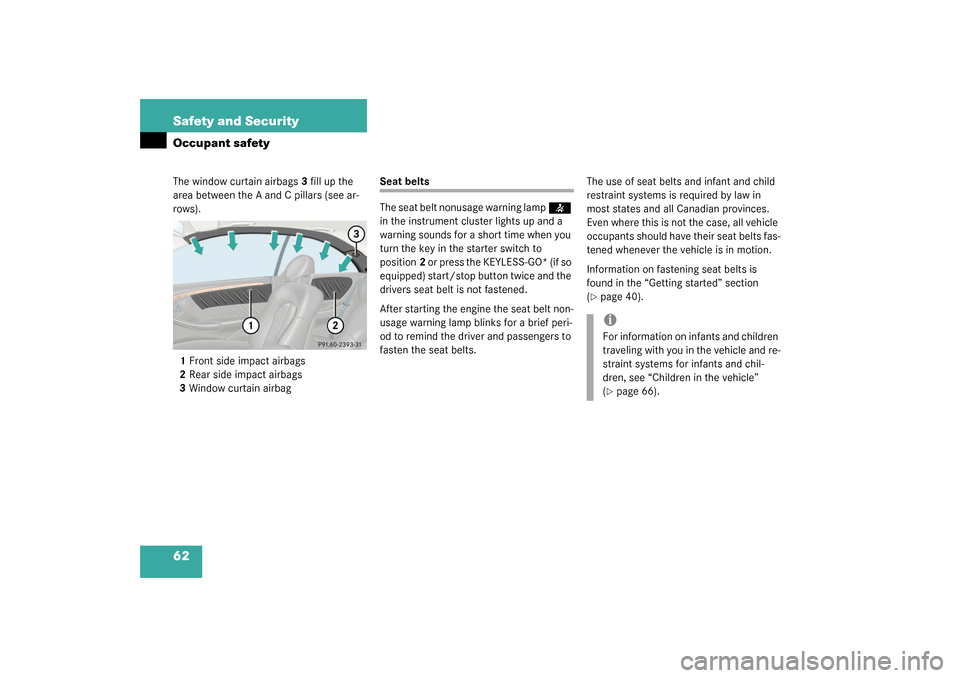
62 Safety and SecurityOccupant safetyThe window curtain airbags 3 fill up the
area between the A and C pillars (see ar-
rows).
1Front side impact airbags
2Rear side impact airbags
3Window curtain airbag
Seat belts
The seat belt nonusage warning lamp
<
in the instrument cluster lights up and a
warning sounds for a short time when you
turn the key in the starter switch to
position2 or press the KEYLESS-GO* (if so
equipped) start/stop button twice and the
drivers seat belt is not fastened.
After starting the engine the seat belt non-
usage warning lamp blinks for a brief peri-
od to remind the driver and passengers to
fasten the seat belts.The use of seat belts and infant and child
restraint systems is required by law in
most states and all Canadian provinces.
Even where this is not the case, all vehicle
occupants should have their seat belts fas-
tened whenever the vehicle is in motion.
Information on fastening seat belts is
found in the “Getting started” section
(
�page 40).iFor information on infants and children
traveling with you in the vehicle and re-
straint systems for infants and chil-
dren, see “Children in the vehicle”
(�page 66).
Page 64 of 394
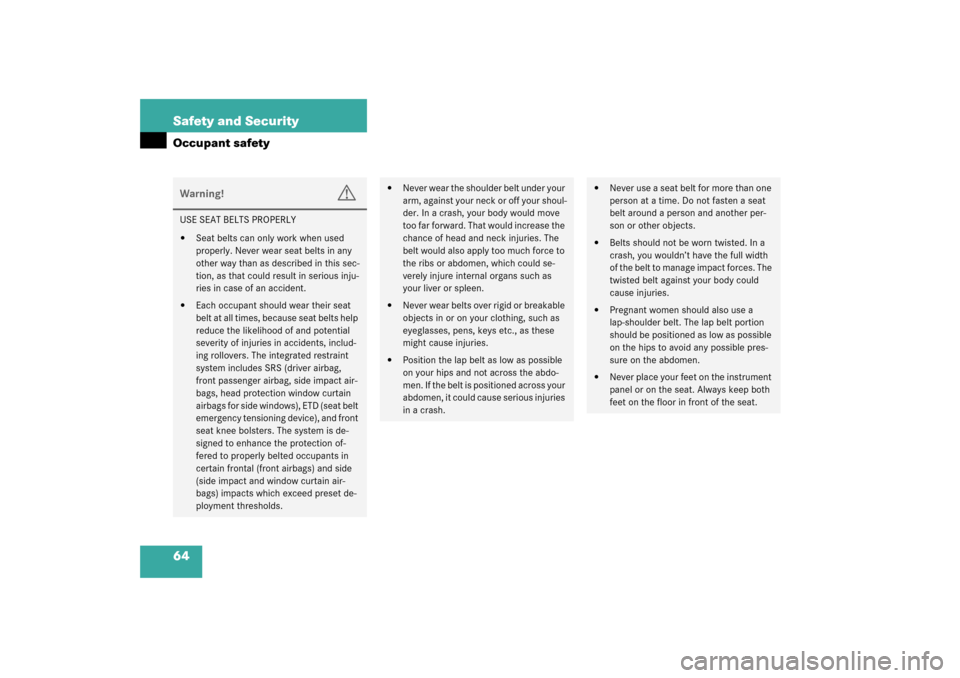
64 Safety and SecurityOccupant safetyWarning!
G
USE SEAT BELTS PROPERLY�
Seat belts can only work when used
properly. Never wear seat belts in any
other way than as described in this sec-
tion, as that could result in serious inju-
ries in case of an accident.
�
Each occupant should wear their seat
belt at all times, because seat belts help
reduce the likelihood of and potential
severity of injuries in accidents, includ-
ing rollovers. The integrated restraint
system includes SRS (driver airbag,
front passenger airbag, side impact air-
bags, head protection window curtain
airbags for side windows), ETD (seat belt
emergency tensioning device), and front
seat knee bolsters. The system is de-
signed to enhance the protection of-
fered to properly belted occupants in
certain frontal (front airbags) and side
(side impact and window curtain air-
bags) impacts which exceed preset de-
ployment thresholds.
�
Never wear the shoulder belt under your
arm, against your neck or off your shoul-
der. In a crash, your body would move
too far forward. That would increase the
chance of head and neck injuries. The
belt would also apply too much force to
the ribs or abdomen, which could se-
verely injure internal organs such as
your liver or spleen.
�
Never wear belts over rigid or breakable
objects in or on your clothing, such as
eyeglasses, pens, keys etc., as these
might cause injuries.
�
Position the lap belt as low as possible
on your hips and not across the abdo-
m e n . I f t h e b e l t i s p o s i t i o n e d a c r o s s y o u r
abdomen, it could cause serious injuries
in a crash.
�
Never use a seat belt for more than one
person at a time. Do not fasten a seat
belt around a person and another per-
son or other objects.
�
Belts should not be worn twisted. In a
crash, you wouldn’t have the full width
of the belt to manage impact forces. The
twisted belt against your body could
cause injuries.
�
Pregnant women should also use a
lap-shoulder belt. The lap belt portion
should be positioned as low as possible
on the hips to avoid any possible pres-
sure on the abdomen.
�
Never place your feet on the instrument
panel or on the seat. Always keep both
feet on the floor in front of the seat.
Page 72 of 394
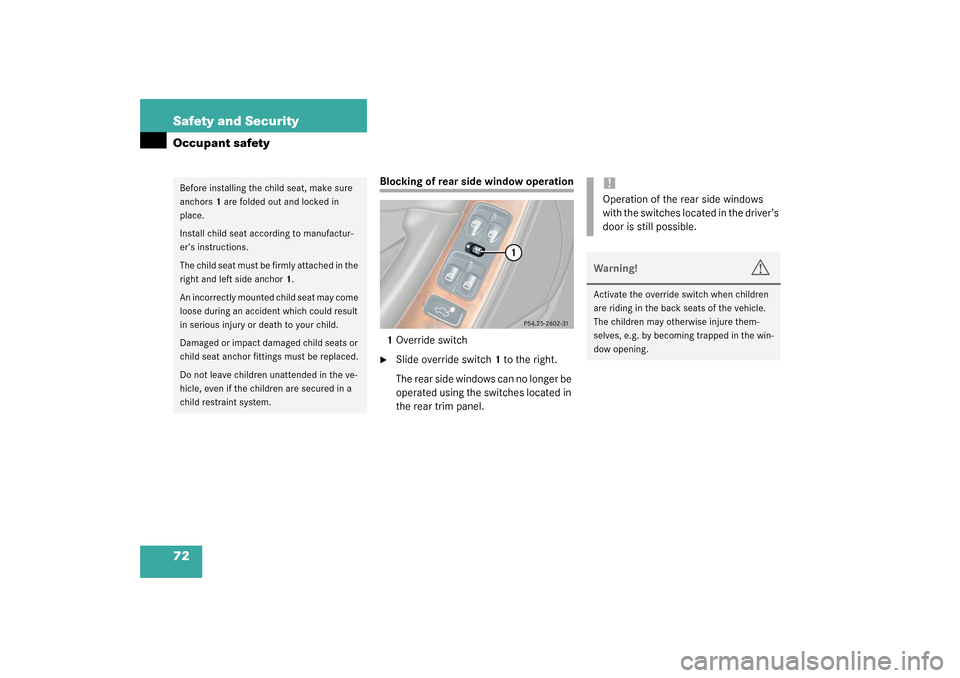
72 Safety and SecurityOccupant safety
Blocking of rear side window operation
1Override switch�
Slide override switch 1 to the right.
The rear side windows can no longer be
operated using the switches located in
the rear trim panel.
Before installing the child seat, make sure
anchors1 are folded out and locked in
place.
Install child seat according to manufactur-
er’s instructions.
T h e c h i l d s e a t m u s t b e f i r m l y a t t a c h e d i n t h e
right and left side anchor1.
An incorrectly mounted child seat may come
loose during an accident which could result
in serious injury or death to your child.
Damaged or impact damaged child seats or
child seat anchor fittings must be replaced.
Do not leave children unattended in the ve-
hicle, even if the children are secured in a
child restraint system.
!Operation of the rear side windows
with the switches located in the driver’s
door is still possible.Warning!
G
Activate the override switch when children
are riding in the back seats of the vehicle.
The children may otherwise injure them-
selves, e.g. by becoming trapped in the win-
dow opening.
Page 83 of 394
83 Controls in detail
Locking and unlocking
Seats
Memory function
Lighting
Instrument cluster
Control system
Automatic transmission
Good visibility
Automatic climate control
Audio system
Power windows
Sliding/pop-up roof*
Driving systems
Loading
Useful features
Page 84 of 394
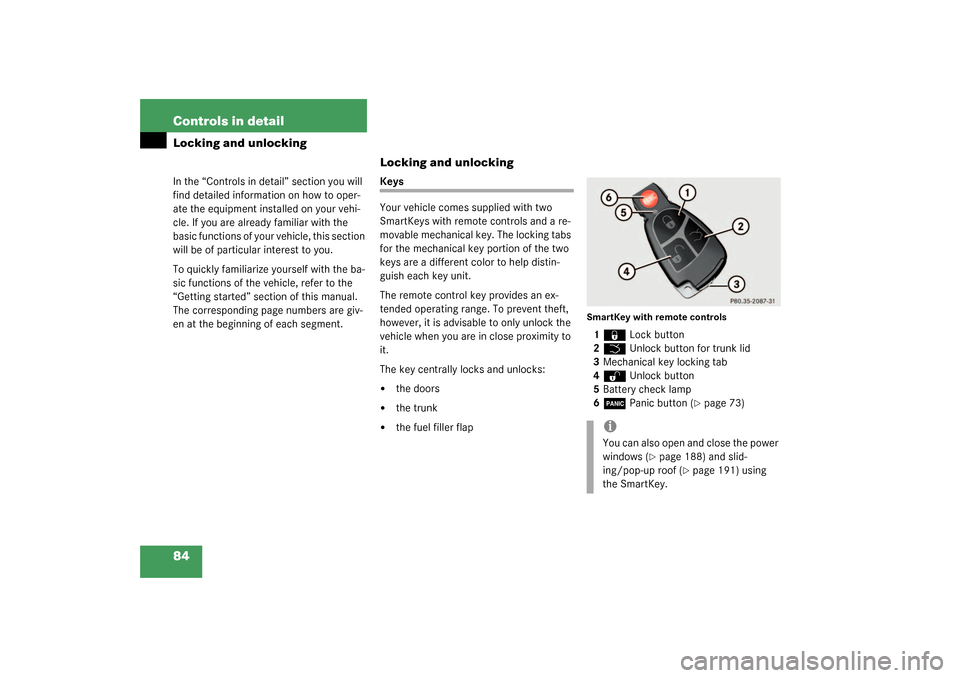
84 Controls in detailLocking and unlockingIn the “Controls in detail” section you will
find detailed information on how to oper-
ate the equipment installed on your vehi-
cle. If you are already familiar with the
basic functions of your vehicle, this section
will be of particular interest to you.
To quickly familiarize yourself with the ba-
sic functions of the vehicle, refer to the
“Getting started” section of this manual.
The corresponding page numbers are giv-
en at the beginning of each segment.
Locking and unlockingKeys
Your vehicle comes supplied with two
SmartKeys with remote controls and a re-
movable mechanical key. The locking tabs
for the mechanical key portion of the two
keys are a different color to help distin-
guish each key unit.
The remote control key provides an ex-
tended operating range. To prevent theft,
however, it is advisable to only unlock the
vehicle when you are in close proximity to
it.
The key centrally locks and unlocks:�
the doors
�
the trunk
�
the fuel filler flap
SmartKey with remote controls1‹
Lock button
2
Š
Unlock button for trunk lid
3Mechanical key locking tab
4
Œ
Unlock button
5Battery check lamp
6
Â
Panic button (
�page 73)
iYou can also open and close the power
windows (
�page 188) and slid-
ing/pop-up roof (
�page 191) using
the SmartKey.
Page 91 of 394
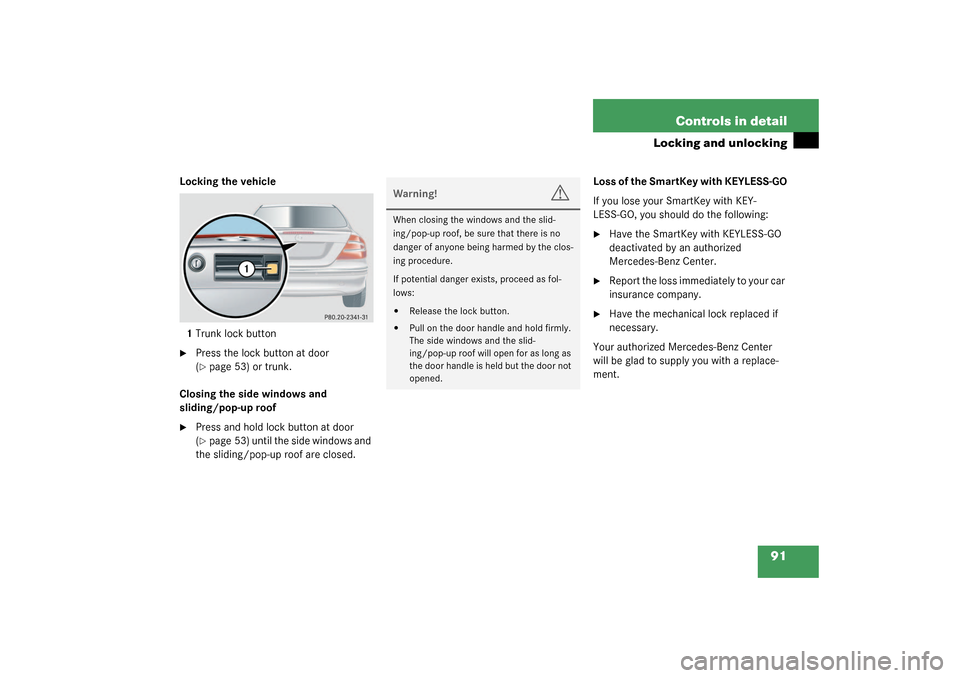
91 Controls in detail
Locking and unlocking
Locking the vehicle
1Trunk lock button�
Press the lock button at door
(�page 53) or trunk.
Closing the side windows and
sliding/pop-up roof
�
Press and hold lock button at door
(�page 53) until the side windows and
the sliding/pop-up roof are closed.Loss of the SmartKey with KEYLESS-GO
If you lose your SmartKey with KEY-
LESS-GO, you should do the following:
�
Have the SmartKey with KEYLESS-GO
deactivated by an authorized
Mercedes-Benz Center.
�
Report the loss immediately to your car
insurance company.
�
Have the mechanical lock replaced if
necessary.
Your authorized Mercedes-Benz Center
will be glad to supply you with a replace-
ment.
Warning!
G
When closing the windows and the slid-
ing/pop-up roof, be sure that there is no
danger of anyone being harmed by the clos-
ing procedure.
If potential danger exists, proceed as fol-
lows:�
Release the lock button.
�
Pull on the door handle and hold firmly.
The side windows and the slid-
ing/pop-up roof will open for as long as
the door handle is held but the door not
opened.